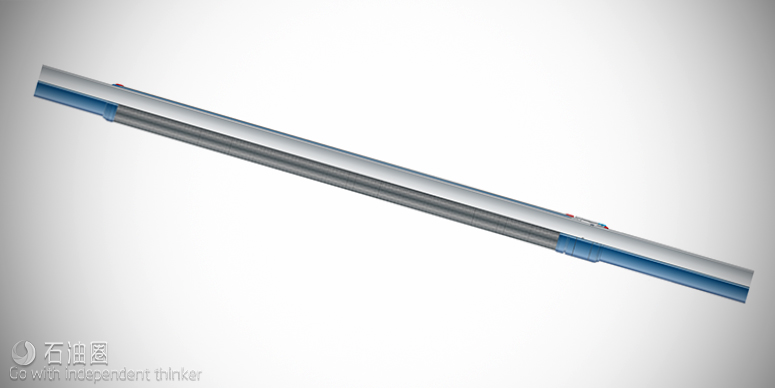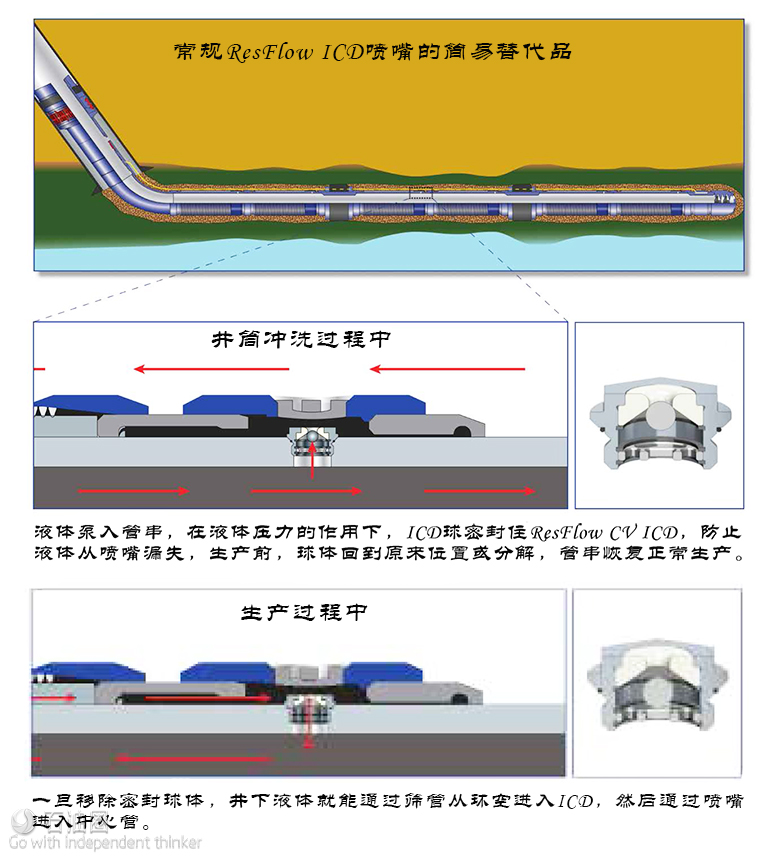The ResFlow CV* check-valve ICD is an inflow control device that eliminates the need to deploy washpipe for well cleanup (fluid displacement) and for setting openhole hydraulically set packers. The check-valve assembly, which includes a ceramic nozzle, a ceramic or aluminum ball, and an aluminum plate, is used instead of the standard ResFlow ICD nozzle assembly within the ICD housing. The check-valve assembly prevents fluid loss through the nozzles during washdown and then controls the flow of hydrocarbons during production in the same way as a conventional ResFlow ICD.
The ResFlow CV ICD is designed for use in openhole completions with certain procedures to help ensure completion string hydraulic integrity, including circulation of fluid to the toe of the well (for example, while the completion string is being run inhole or during fluid displacement) and application of pressure to wellbore fluids. In extended-reach wells, eliminating washpipe deployment—and consequently, washpipe weight and rental costs—helps reduce costs and increase operational efficiency, safety, and logistics. It also enables the use of longer BHAs, thereby increasing reservoir access.
ICDs deployed without washpipe with no fluid lost through nozzles
During the running in hole of the screen completion, the ResFlow CV ICD ball closes the check valve as pumping pressure is applied, preventing the fluid from leaking into the annulus through the nozzle. The fluid must instead travel the length of the completion string to the toe before returning up the annulus. This design feature also enables the setting of openhole hydraulically set packers.
Fluid path through nozzle reinstated before start of production
The aluminum ball and plate are removed from the wellbore by a standard fluid displacement technique with a breaker system. The ceramic ball can be used to control fluid loss while the upper completion is being run or if packers need to be set. When the pressure is released or pumping stops, this ceramic ball drops back onto the plate, enabling fluid to flow into the string again. It eventually flows back to surface with produced hydrocarbons, and the seat erodes. Afterward, the check-valve ICD behaves like a conventional ResFlow ICD nozzle.
During washdown:
When fluid is being pumped downhole, fluid pressure causes the ball to seal the ResFlow CV check-valve ICD assembly, preventing fluid loss through the nozzle. The ball dissolves or flows back before production starts, opening the valve to flow.
During production:
When the ball is removed, hydrocarbons can flow from outside the annulus through the screen filter into the ICD housing and then into the basepipe through the nozzle.
APPLICATIONS
■ Extended-reach completions
■ Mid-to-high tier completions
■ Stand-alone screen completions in oil-producing reservoirs
■ Multizone openhole completions with hydraulic-set packers
■ Openhole horizontal to highly deviated wells
■ Carbonate and sandstone reservoirs
BENEFITS
■ Saves rig time, especially beneficial for offshore operations
■ Eliminates washpipe rental costs
■ Enables longer BHAs and increased reservoir access through reduced string weight
■ Streamlines operational logistics
■ Simplifies operations due to elimination of requirement for a fluid loss control device
FEATURES
■ Drop-in replacement for standard ResFlow ICD nozzle
■ Preservation of washdown capability without a washpipe
■ Ability to function through multiple pressure cycles before production starts
■ Ability to use openhole, hydraulically set packers
■ Proven ball check-valve technology
■ No protrusion into basepipe ID
■ Ball options:
● aluminum ball dissolved before production with acid-base breaker system
● ceramic ball produced out with hydrocarbons
Case study
North Caspian Extended-Reach Wells Completed Without Washpipe, Cutting 2 Days and USD 2 Million per Well
Design of new ResFlow CV check-valve ICD eliminates need for washpipe to displace oil-base mud
Use of washpipe not feasible in extended-reach wells requiring sand control
An operator was developing an oil field with openhole extended-reach wells that had measured depths up to 5 mi [8 km] and a total vertical depth of approximately 0.93 mi [1.5 km]. A sandstone formation with a large gas cap necessitated sand screens with inflow control devices (ICDs) to minimize early gas breakthrough. Rotating screens were selected as the primary completion installation technique in this extended-reach environment, where openhole sections reached up to 3.1 mi [5 km]. To reduce torque friction and address shale instability, oil-base mud (OBM) was used during drilling and running in hole.
In the first six extended-reach wells, the OBM was left in the open hole until the upper completion was run and was then partially recovered during well lifting and production. Solids in the mixture of freshwater, crude oil, OBM, and brine had damaged the pumps and other surface facilities and requiredthem to be refurbished after every well startup. And the incomplete cleanup had prevented the toe intervals from producing efficiently. As a result, the operator decided that the OBM should be displaced before the wells were lifted.
Various options to displace the OBM were evaluated. Running washpipe with screens with concentric string rotation was not feasible and would have increased the weight of the completion string, increasing drag. In wells as long as the ones planned, the heavy washpipe would have tested the tensile limits of the service tool and made it difficult to run the screens to total depth. Coiled tubing was not available, and running washpipe along the openhole section in a separate trip would have added too much time to the project. The operator asked Schlumberger to find an alternative method to displace the OBM.
ResFlow CV check-valve ICD eliminates need for washpipeSchlumberger recommended the new ResFlow CV check-valve ICD, which does not require washpipe. This ICD, which includes a ceramic nozzle, a ceramic or dissolvable aluminum ball, and an aluminum plate, prevents fluid loss through the nozzles during washdown and then controls the flow of hydrocarbons during production like a standard ResFlow* inflow control device.
The ICDs were run in hole. The pressure of the fluid being pumped down the completion string caused the ball to flow onto the check-valve assembly, preventing the fluid from leaking into the annulus through the nozzle. After the fluid traveled the length of the completion string to the toe of the well and then back up the annulus, the ball and plate dissolved with the standard acid-base breaker system used for well cleanup. At that point the ResFlow CV ICD worked like a standard ResFlow ICD nozzle, helping balance inflow along the wellbore.
Operation trims 2 days, saving up to USD 2 million per well
The five wells were successfully completed, with no Schlumberger-related NPT. Eliminating deployment of the washpipe saved the operator 2 days and approximately USD 2 million per well.
New ICD Design Eliminates Need for Washpipe, Trims 24 Hours from North Sea Project, and Saves USD 800,000
Use of ResFlow CV check-valve ICD enables successful sand control completion of extended-reach, highly deviated well—with zero NPT
Running washpipe is impractical in extended-reach, highly deviated wells
An operator needed to drill several wells in an oil field offshore Norway. This field is characterized by variations in permeability, with several shale zones interbedded between formation sand. The operator planned to drill a long, horizontal well with a measured depth of 14,682 ft [4,475 m] and a total vertical depth of 6,476 ft [1,974 m]. The well would have a 90° deviation and an openhole span of 4,921 ft [1,500 m]. Because of the field’s geology, wells in this field had previously been completed with standalone screens and ResFlow* inflow control devices (ICDs) that use nozzles to regulate flow along the length of the reservoir. These ICDs are typically run with washpipe (the inner string) to permit washdown operations while the screens are being run inhole. Washpipe also permits the placement of filtercake breaker along the entire openhole section after the screen reaches total depth (TD).
However, washpipe rental and rig time to run it in and pull it out increase costs, and the process complicates logistics and creates safety risks. Moreover, in wells as long as the one planned, the heavy washpipe tests the tensile limits of the service tool and makes it difficult to run the screens to TD.
ResFlow CV ICD assembly eliminates need for washpipe
To reduce the costs and risks, Schlumberger recommended the use of the new ResFlow CV checkvalve ICD, which does not require washpipe. The check-valve assembly includes an aluminum or ceramic ball, a ceramic nozzle, and an aluminum plate. It replaces the standard ResFlow ICD nozzle assembly in the ICD housing.
When this ICD is run inhole, the pressure of the fluid being pumped down the completion string causes the ball to seal the check-valve assembly. Fluid is thus prevented from leaking into the annulus through the nozzle and must travel the length of the completion string to the toe before returning up the annulus.
In this particular case, the aluminum ball and plate were dissolved before production with the standard acid-base breaker system used for well cleanup. At that point, the ResFlow CV check-valve ICD worked like the standard ResFlow ICD nozzle, helping balance inflow across the completion.
Operator trims 24 hours and saves USD 800,000
The well was successfully completed with zero NPT related to Schlumberger services or products. Because of the lighter weight of the assembly string, the completion was run without difficulty to TD. Eliminating the washpipe rental expenses and rig- and service-related costs saved the operator 24 hours and approximately USD 800,000.


 石油圈
石油圈

